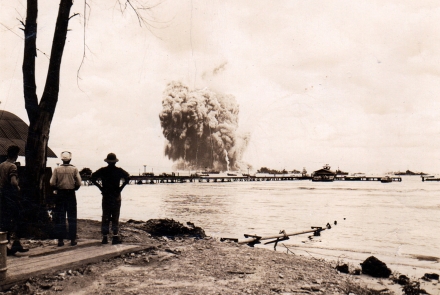
Image from US Navy, Seeadler Harbour, Manus, 1944
Benefits for all in Manus being a base for US, Australia forces
Australia’s partnership with PNG can grow in new ways, Anthony Bergin writes.
The revelation that plans by Papua New Guinea to build a port on Manus Island could see China gain a foothold there is disturbing.
The PNG government is looking more to China to fund large infrastructure projects, raising the longer term prospect of a Chinese military presence on the island.
It is worrying in part because a large multi-user port on Lombrum would seem to be at risk of being large but not having enough “multi users” to make it economic, raising the issue of unpayable debt for PNG leaders after the flush of joy over construction ends.
So what should Australia be doing? Step one would be working with PNG on the feasibility and sustainability of the proposal. Step two would be considering how any Manus facilities might be used in partnership.
Manus has a long naval history, including more than 25 years as a base for the RAN. After an amphibious landing by US forces in February 1944 to take back the island from the Japanese, Manus became a major US naval and air base. Before the invasion of The Philippines in late 1944, there were more than 800 ships in Seeadler Harbour, Manus Island.
Installations included wharves and floating docks, four airfields, living quarters for 150,000, a 3000-bed hospital, and fuel depots, supply stores and repair workshops.
After negotiations between the US and Australian governments, Australia took over the Lombrum base in 1949. By that time most of its facilities had either been destroyed or removed.
The base, commissioned by the RAN as HMAS Tarangau, remained in Australia’s hands until 1974, when it was handed to the PNG government to become the patrol base for the PNG Defence Force. Maintaining the base at Lombrum has been difficult. Its remote location makes support expensive, with training and workshop facilities having deteriorated over the years.
As was shown during World War II, Manus is a fine strategic location that dominates this part of the Pacific. It is in a key position for controlling access to Australia through the archipelagic arc to our north and northeast.
The RAN and foreign navies, including the US Navy, used HMAS Tarangau at Manus extensively as a fuelling stop for ships transiting between east Asia, Australia and elsewhere in the South Pacific.
Australia should now be increasing its maritime presence in that archipelagic arc. RAN’s use of Manus would greatly facilitate that presence. As well as naval facilities, Momote airfield at Manus would be a valuable base for Australian and allied maritime surveillance aircraft.
Manus could also be an option to support American naval units, as the US is interested in examining locations to support operations in the Pacific. Trilateral negotiations could be opened up now between Australia, the US and PNG regarding access to Manus as a forward operating base.
This would also assist in PNG’s overall maritime security. PNG would gain experience in operating more closely with Australian and US naval and air surveillance forces, which could contribute to PNG’s surveillance needs.
The level of surveillance and patrol of PNG’s waters is inadequate. PNG boats carry out patrols only when they are funded by the country’s fisheries agency or Australia’s defence co-operation program. There are currently no patrols to remote coastal areas and islands to protect sovereignty, prevent illegal activity and support nation-building. Air surveillance of PNG’s large area of maritime jurisdiction is conducted only on an occasional basis.
This is a time for PNG, Australia and the US to think creatively. Avoiding an unsustainable project is perhaps the least ambitious outcome. The opportunity for PNG to create stronger maritime surveillance capabilities and close operating partnerships with visiting US and Australian naval units is worth taking up.
Maybe Scott Morrison can show Australia’s partnership with PNG can grow in new ways under his watch. Foreign Minister Marise Payne can be an effective advocate based on her knowledge and experience from her previous Defence portfolio.
Anthony Bergin is a senior analyst at the Australian Strategic Policy Institute and ANU’s National Security College.
This post was first published in The Australian and republished with permission.
Updated: 27 July 2024/Responsible Officer: Crawford Engagement/Page Contact: CAP Web Team












